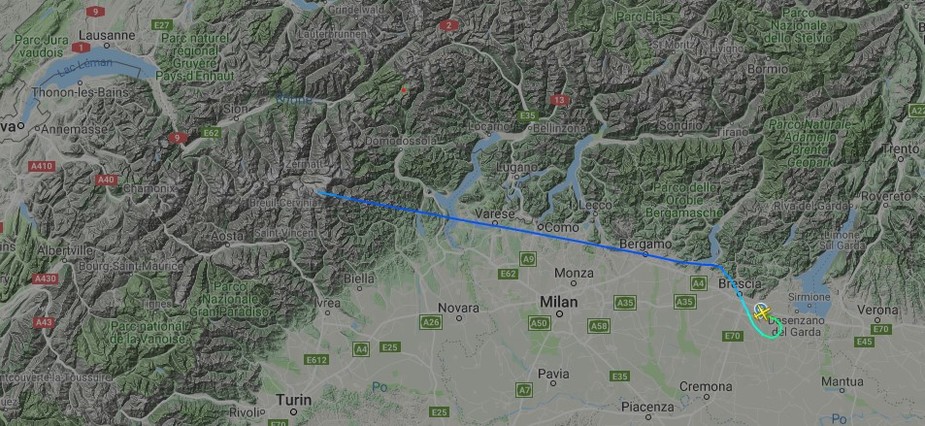Of course Ipads (and most other tablets except the low power ones) do shut down in heat, but that is not a good reason for flying into terrain in VMC.
It could well be a reason for turning into the wrong canyon… because most tablet users don’t have a Plan B for when it packs up.
Can anyone confirm how far from the crash site the FR24 track stops?
What if there was a major electrical problem or a serious fire? That might account for the eyewitness reports and also the early termination of the FR24 track.
The crash site was posted earlier (with the electricity pylons).
The FR24 track end looks reasonable. Tracking stops in all sorts of places. FR24 interpolates (with fairly visible straight line segments) but this happens only if it regains tracking. Once tracking is not regained, it displays the last track point. And there aren’t going to be many tracking stations in this area.
Anyway, the distance between the entrance of the valley near Brig and the Crash site is only about 5 miles or so. Two minutes of flight. It looks he wasn’t aware of how short the distance / time remaining to the pass was. A loaded Arrow at 8000 feet DA will (depending on his technique) not climb more than a few hundred feet in that time.
Given these factors, all speculation about technical failures is IMHO not plausible. As pilots, we also tend to try to find technical failures when accidents happen. Even when they happen to others. But practice has showed that this is very seldom the case. In such an environment, just a couple of piloting errors (which happen every day, to all of us) in a row can lead to this outcome. This is the very most likely.
Btw, a CFIT is not the only plausible circumstance. Just the same, he might have been surprised by all the terrain ahead to his left and right, and in his fright, pulled more and more until a stall happened. Again, all this is likely, looking at the more recent accidents in the Swiss Alps.
boscomantico wrote:
Given These factors, all speculation about technical failures is IMHO not plausible. As pilots, we also tend to try to find technical failures when accidents happen. Even when they happen to others. But practice has showed that this is very seldom the case. In such an environment, just a couple of piloting errors (which happen every day, to all of us) in a row can lead to this outcome. This is the very most likely.
Indeed pilot error is usually the cause. Such a tragic crash with a young family.
Graham wrote:
Can anyone confirm how far from the crash site the FR24 track stops?What if there was a major electrical problem or a serious fire? That might account for the eyewitness reports and also the early termination of the FR24 track.
FR24 cuts if it no longer has a relay signal.
Here a lot of theft are not displayed at all by FR24
This plane landed in Sion this morning despite the fact that the FR24 track stops at the Matterhorn

boscomantico wrote:
pulled more and more until a stall happened
And it’s much easier in hilly/mountainous terrain where you’re concentrating on looking out the window (to avoid said terrain) and simultaneously presented with a false horizon (common in mountainous terrain). What you may perceive to be a normal climb attitude is actually several degrees more nose up, add to this high density altitude, attempt to make a turn, and you can inadvertently stall with very little room to recover.
Unfortunately stall training we get in the PPL is just not realistic.
alioth wrote:
What you may perceive to be a normal climb attitude is actually several degrees more nose up, add to this high density altitude, attempt to make a turn, and you can inadvertently stall with very little room to recover.
I guess you have to climb based on stick/airspeed as you do when IFR?
While it seems obvious, it is not: one day I was asked to takeoff with a TMG on a short runway with a small 300ft hill ahead, I just climbed at 45kts instead of 60kts (confused hill top with horizon + tried to avoid the hill), the stall speed is at 38kts, the motor-gliding instructor took control flew toward the hill before initiated the turn at 60kts
This happened in flat UK terrain, while I understand whole saga was staged by the FI for “illustration”: we simply don’t fly tugs+gliders on that runway  , it was still an eye opener how one could easily lose control when things gets busy on takeoff…
, it was still an eye opener how one could easily lose control when things gets busy on takeoff…
There is an important item, IMO, that hasn’t been discussed here yet: most pilots are familiar with the ‘horizon picture’ over flat earth, and because flat earth is mostly below them, this isn’t a factor; when they suddenly are flying in the mountains, where many of those are higher than the own position, it can become pretty easy to misjudge your own altitude, i.e. in reference to the ridge in front of you.
High density altitude, bad climb performance worsened by a foehn headwind, a high cockpit, pitch up attitude, unfamiliar horizon picture (or maybe no picture at all ?) helmet fire, and very short time to react…
Feet and Mitres (reference mainly Swiss charts).
There is approximately a threefold difference, If you’re in the Alps a ‘gross error check’ tells you that figures like 2000 and 3000 are most likely metres.
Obviously, one should know for sure, but just the basic ‘gross error check’ says they can’t be feet – or at least very very unlikely.